
* Corresponding author. Tel.: +7 (342) 2-198-119
E-mail addresses: t.ablyaz@mail.ru (T. R. Ablyaz)
© 2019 Growing Science Ltd. All rights reserved.
doi: 10.5267/j.esm.2019.3.003
Engineering Solid Mechanics 7 (2019) 131-136
Contents lists available at GrowingScience
Engineering Solid Mechanics
homepage: www.GrowingScience.com/esm
Electrolytic plasma polishing technique for improved surface finish of ED machined components
T. R. Ablyaza*, K. R. Muratovb, L. A. Ushomirskayab, D. A. Zarubinb, and S. S. Sidhuc
aPerm National Research Polytechnic University, Komsomolskiy Avenue, 29, Perm, Russia
bPeter the Great St. Petersburg Polytechnic University, Polytechnicheskaya Street, 29, St.Petersburg, Russia
cBeant College of Engineering & Technology, National Highway, 15, Gurdaspur, India
A R T I C L EI N F O A B S T R A C T
Article history:
Received 12 December, 2018
Accepted 18 February 2019
Available online
1 April 2019
The development of techniques that allow producing high-finish surfaces of geometrically-
complex parts of difficult-to-machine materials by electrical discharge machining (EDM) is an
emerging research area. The aim of this work is to study the application of electrolytic-plasma
polishing technique for the high-quality surface finish of the parts obtained by EDM process. The
structural alloy steel 38KH2N2MA (GOST 4543 – 71) was selected as the processing material.
The morphology of the machined surface was examined using optical micrographs. It was observed
that applying the electrolytic plasma polishing for the duration of 5 minutes results in reducing the
surface roughness of the ED machined surface by a factor of 5. It is also concluded that the
combined action of EDM with electrolytic plasma polishing method is suitable for attaining the
desired surface finish.
© 2019 Growin
g
Science Ltd. All ri
g
hts reserved.
Keywords:
Electrical discharge machining
(EDM)
Electrolytic plasma polishing
Roughness
Quality
1. Introduction
The Electrical Discharge Machining (EDM) is well known technique for producing the geometrically-
complex parts with enhanced physical and mechanical properties. EDM of metals and other conductive
materials is based on the melting and evaporation of the material, induced by pulses of electrical energy
in the discharge channel, ignited between the surface of the workpiece and the electrode tool, immersed
in liquid (dielectric; usually a non-conductive environment is denoted as working liquid). Successive
pulsed discharges lead to melting and evaporation of the micro-portion of material from the surface of
the workpiece. The hydrodynamic forces that are developed in the dielectric remove the molten material
from the discharged zone, the electrode-tool penetrates into the workpiece forming a recess
corresponding to a shape of the electrode, thereafter (Zhurin, 2005; Ablyaz et al., 2012, 2016; Ablyaz,
2016; Ablyaz & Zhurin, 2016). Fig. 1 represents the schematic of the processes occurring in the inter-
electrode space (Zhurin, 2005; Shabgard, 2014; Ablyaz, 2016; Ablyaz & Zhurin, 2016; Ablyaz et al.,
2016; Ablyaz & Borisov, 2017).

132
Fig. 1. The schematic diagram of the processes
occurring in the inter-electrode space
Fig. 2. A hole formed on surface of material after
a single pulse: 1 –melted metal; 2 – white layer; 3
– cushion around the hole; 4 – workpiece
The electrical discharge (2) generates between the electrodes: anode (1) and cathode (3) as shown in
Fig. 2. The heat released in the discharge zone leads to melting and partial evaporation of the electrode
material (the melting zone is shown by the dotted line in the scheme). The molten electrode material is
ejected from melting zone with the help of the working fluid (5) surrounding discharge area that
evaporates and decomposes. Fumes and gases in the form of bubbles (4) are removed from the inter-
electrode space together with part of the fluid and solid particles (7) of spherical and fragmental shapes.
It has been found that hundreds of particles of different size forming the so-called single hole are removed
from the surface of the material as a result of a single discharge (Zhurin, 2005; Ojha et al., 2010; Ablyaz
et al., 2012; Shabgard, 2014; Ablyaz, 2016; Ablyaz & Zhurin, 2016; Ablyaz et al., 2016; Ablyaz &
Borisov, 2017). With the increase of pulse energy by changing the processing parameters, an increase in
the number of larger particles as well as their diameters is witnessed. These effects significantly influence
the surface quality. A single hole is shown in Fig. 2 (Tsai, 2003; Zhurin, 2005; Janmanee & Muttamara,
2010; Ojha et al., 2010; Ablyaz et al., 2012; Dey & Roy, 2013; Shabgard, 2014; Ablyaz, 2016; Ablyaz
& Zhurin 2016; Ablyaz & Borisov 2017).
One of the indicators of the quality of the workpiece surface processed by electric current pulses is
the roughness. In general, the EDM processes for manufacturing of different parts do not provide for
subsequent finishing operations and most of the modern electrical discharge machines allow obtaining
the machined surface roughness (Ra) in the range of 0.1-0.4 µm. These indicators of roughness are
achieved by connecting the electrode part to the negative pole of the pulse generator and setting the
modes with minimal pulse energy. However, the processing using the finishing cutting conditions is
characterized by low productivity of the EDM process. In few research studies, it has been shown that
during the machining of steel 38KH2N2MA using the copying-broaching machine for finishing-
processing, the performance is 0.05 mm/h (Ablyaz & Borisov 2017). Low productivity of the EDM
process leads to an increase in processing time and in the cost of the finished product. Hence, the
development of the EDM process is often set to more rough indicators of the quality of the processed
surfaces, which does not allow achieving the full performance of the product.
Nowadays, the scientific and technical research is focused on the development of technologies
improving the roughness of geometrically-complex surfaces of parts. The literature survey has revealed
that the use of mechanical methods of treatment is accompanied by technological and economic
constraints associated with the development of specialized equipment, tools, and often manual labor. The
application of chemical and electrochemical polishing electrolytes is often accompanied by the high cost
of ecological safety measures for humans and environment in terms of waste disposal due to the high
toxicity of the process.
An adequate, yet innovative solution to this problem is the use of Electrolytic Plasma Polishing (EPP)
as a surface treatment route that generates smoother and glossy surfaces with improved physical
properties. The EPP method, introduced in late seventies of twentieth century (Duradzhi et al., 1979), is

T. R. Ablyaz et al. / Engineering Solid Mechanics 7 (2019)
133
based on electrical discharge phenomena in the system "metal-electrolyte", where the workpiece plays a
role of the anode. It is a combination of both EPP and conventional electrolysis process and is based on
anodic dissolution which is characterized by plasma chemical reactions. The polishing of metals takes
place generally at a voltage of 200-350 V and current density of 0.2-0.5 A/cm2 and immersed in a an
aqueous electrolytic solution. Around the anode at a voltage of 200 V in the transition from nucleate
boiling to stable film, a thin (50-100 µm) Vapor-Gas Shell (VGS) is formed. The electric field in the
VGS reaches 104-105 V/cm and increases subsequently by getting closer to the micro-sites. These sites
are migrating over the surface, micro-plasma discharges, and this effect provides comprehensive
chemical and physical impact on the material surface. The micro discharges provide significant energy,
and this process reduces the height of asperities of the surface that leads to its polishing. The EPP
technique is environmentally safe and does not require the use of acids, alkalis, and other hazardous
substances in dangerous concentrations (Kulikov et al., 2010; Ushomirskaya, et al. 2012; Zarubin &
Ushomirskaya, 2016). Fig. 3 shows the schematic of EPP process.
Fig. 3. Schematic of EPP procedure
The goal of this work is to investigate the possibilities of EPP application for the surface treatment of
the machined part obtained by copying-broaching electrical discharge machine.
2. Materials and methods
The structural alloy steel 38KH2N2MA (GOST 4543 – 71) was selected as the processing material.
The experimental sample was the plate with the size of 10x20 mm and thickness of 2 mm. The EDM of
the specimen was performed by Electrical discharge machine (Electronica, Smart CNC) with copying-
broaching system, in the presence of working fluid (dielectric, I-20A). The in-process parameters are
shown in Table 1, where T-on is on-time of pulses (µs), T-au is the duty cycle of the pulse (%), U is the
voltage (V), and I is the current (A). The depth of cut was 0.4 mm.
Table 1. Parameters of EDM
Sample
no.
Processing Parameters
I (А) U(V) T-on, µs T-au, %
1 6 50 50 26
2 50 50 50 26
3 20 50 50 26
4 3 50 50 26
5 1 50 50 26
After machining of samples based on the value of depth using different parameters of EDM, the
roughness of the machined surface was measured followed by microscopic analysis of the structure of
the surface. The roughness was measured using ‘Mahr S2 Perthometer’ as roughness indictor. An
analysis of the structure was performed using Olympus light microscope at magnification of 200 X. The
EPP of EDM samples was carried out on the laboratory equipment "Polytech-15" at the power of 15 kW
using the partial immersion technique. For visual observation of the result, the samples of steel

134
38KH2N2MA were dipped in a bath of electrolyte with the half locked by a clip on the upper part. The
positive terminal of the power source was connected directly to the sample, while the working bath was
connected to a negative terminal. The voltage was set to 270 V. To differentiate the level of the DC
output voltage, the “Polytech-15” was equipped with a laboratory three-phase auto-transformer. The
electrolyte contained the solution of salt in distilled water. The electrolyte was represented by three-
component solution in the following concentrations (wt.%): ammonium chloride NH4Cl – 3%,
ammonium sulphate (NH4)2SO4 - 1%, Trilon B – 0.5%. The purity of substances was pure for analysis.
Each component of the solution was weighed on the electronic balance "Massa-K VK 150.1". The
preparation of the solution was performed by successive addition of the components into water heated to
60°C with constant stirring. The working temperature of electrolyte was 90°C and the processing time
of the experimental sample was 5 minutes (Kulikov et al., 2010; Ushomirskaya et al., 2012; Zarubin &
Ushomirskaya, 2016).
After machining, the voltage was disconnected and the sample was removed from the bath, washed
in warm water, and then dried by air. The roughness was measured again on the surfaces processed by
EPP, and the microscopic analysis of the structure of the treated surface was also performed.
3. Results and discussion
During the EPP of samples obtained by electrical discharge machine with copying-broaching system,
stable plasma of anomalous glow discharge was formed around the sample immersed into electrolyte
when the voltage was applied. As a result of complex electrochemical and electrical impact on the surface
of the sample, the smoothing of asperities (polishing) had been achieved. After treatment, the sample
surface acquired metallic luster. It was established that by decreasing the temperature of the electrolyte
below 90°C, the thickness of VGS was reduced leading due to the effect of anode heating. The effect of
the polishing in this case was absent; the sample surface was covered with black spots. Table 2 presents
the measurement of height of asperities as results obtained after the EDM using factors reported in Table
1, and the results of the same samples analyzed after EPP.
Table 2. Surface roughness of the samples
Sample no I (А) Ra after EDM Ra after EPP
1 6 4.6 1.4
2 50 7.7 1.6
3 20 6.7 1.4
4 3 1.6 0.4
5 1 1.5 0.4
The height of asperities obtained after the ED machined workpiece has been reduced by a factor of 5
(average) with the use of the EPP technique. In Fig. 4, the surface profiles of sample no. 2 and 4 after
EDM are shown with their respective roughness values. In Fig. 5, the surface profiles of sample no. 2
and 4 after EPP are shown with their respective roughness values.
(a) (b)
Fig. 4. Profiles of samples surfaces after EDM : a) sample No. 2 and b) sample No. 4

T. R. Ablyaz et al. / Engineering Solid Mechanics 7 (2019)
135
(a) (b)
Fig. 5. Profiles of sample surfaces after EPP : a) sample No.2 and b) sample No.4
The analysis of profiles in Fig. 5 shows that after the EPP, the smooth projections of single holes
(formed during EDM) have been achieved. From Fig. 5(b), it is evident that sample no. 4 witnessed
62.4% decline in roughness depth, wherein, the maximum height of asperities (Rmaх) decreased from the
10.9 µm (after EDM) to 4.1 µm (after EPP). Similarly, 83.6% reduction (Fig. 5(a)) in the Rmax of sample
no. 2 has been recorded i.e. roughness depth decreased from 60.6 µm (EDM) to 9.9 µm (after EPP).
Besides, this is a favorable phenomenon that also assists in higher material removal rate (MRR) as
depicted by many researchers (Bains et al., 2015). It can be related to re-soilidification of melt debris in
the machining zone and as a result, at high discharge current (50A), capacitance is generated by
interaction of sample and electrode. Owing to this, an abrupt peak energy is developed that makes the
surface rougher. The mean spacing of the irregularities (Sm) after the EPP had increased to 421.4 µm
compared to 197.4 µm after the EDM for sample no. 4. The increase in the average step leads to the
increase in the density of the contact between the surfaces. Fig. 6 and Fig. 7 summarize the analysis of
the microstructure of the surfaces of the workpiece (samples no.2 and 4) after EDM and subsequent EPP
route.
(a) (b) (a) (b)
Fig. 6. Microscopic analysis (magnification 100
x) of the sample no. 4 : a) the surface after EDM
and b) the surface after EPP
Fig. 7. Microscopic analysis (magnification 100 x)
of the sample no. 2 : a) the surface after EDM and
b) the surface after EPP
Surface analysis of the sample no.4 revealed that after the EDM the surface was characterized by a
large quantity of stacked holes (Fig. 6a) and EPP treated surface exhibited better topology than ED
machined sample. The traces of melted metal were visible at the boundaries of the holes. The surface of
the sample 2 (Fig. 7a) after the EDM was characterized by the increased size of the single hole without
clear boundaries. There were areas of increased melting of metal. After the EPP (Figs. 6b and 7b), there
were no distinct traces of single holes on the treated surfaces. The surface was smooth, areas of abrupt
melting metal were not observed. It has been found in this study that for processing of the workpiece by
the method of EDM to ensure the surface roughness of 1.6, it is necessary to use the factors with minimum
pulse energy (sample 4). It has been shown that to achieve the same roughness values, the technology of
finishing treatment by EPP combined with more efficient mode of EDM (trial 2) should be used.
4. Conclusions
The following conclusions have been drawn from this research study:
The possibility of application of EPP technology to improve the surface quality of 38KH2N2MA steel
after EDM has been validated.










![Đề thi Công nghệ tạo hình dụng cụ năm 2020-2021 - Đại học Bách Khoa Hà Nội (Đề 4) [Kèm đáp án]](https://cdn.tailieu.vn/images/document/thumbnail/2023/20230130/phuong62310/135x160/3451675040869.jpg)


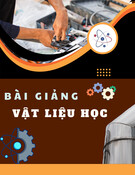
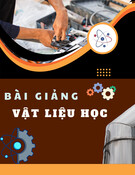
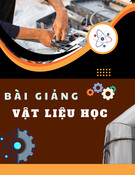


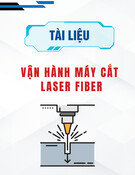



![Bài tập môn Cơ sở thiết kế máy [năm] [mới nhất]](https://cdn.tailieu.vn/images/document/thumbnail/2025/20251008/ltgaming1192005@gmail.com/135x160/26601759980842.jpg)
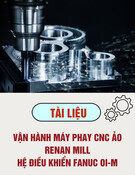
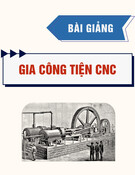
![Tài liệu huấn luyện An toàn lao động ngành Hàn điện, Hàn hơi [chuẩn nhất]](https://cdn.tailieu.vn/images/document/thumbnail/2025/20250925/kimphuong1001/135x160/93631758785751.jpg)
